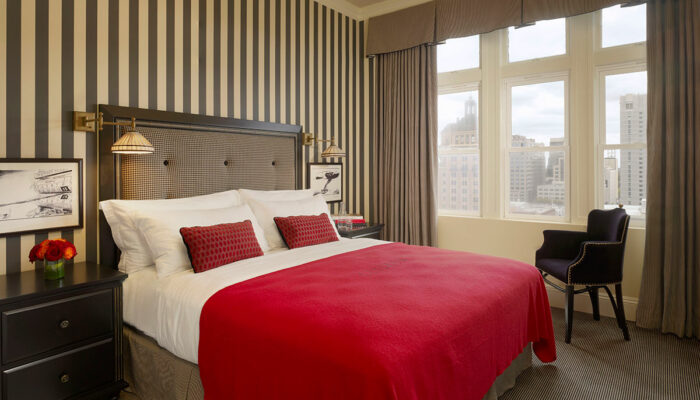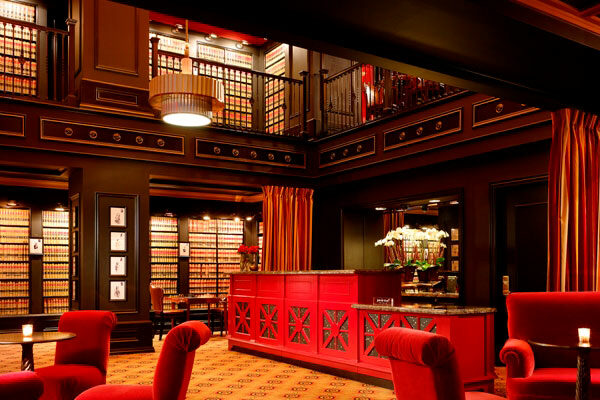Project : The Citizen Hotel
Historic Building Selected as Boutique
Hotel in California Capitol
 The Citizen Hotel is one of Sacramento’s oldest and most beautiful skyscrapers. The boutique hotel features 198 rooms, five penthouses, a ball room, as well as a 3,000 square foot dining terrace overlooking the State Capitol. Joie De Vivre (now known as JdV by Hyatt) retrofitted downtown Sacramento’s historic Cal Western Life Building to create The Citizen Hotel. An originator of character and imagination in boutique hospitality, JdV by Hyatt has helped define an industry and today comprises the largest collection of boutique properties in California, with locations across America.
The Citizen Hotel is one of Sacramento’s oldest and most beautiful skyscrapers. The boutique hotel features 198 rooms, five penthouses, a ball room, as well as a 3,000 square foot dining terrace overlooking the State Capitol. Joie De Vivre (now known as JdV by Hyatt) retrofitted downtown Sacramento’s historic Cal Western Life Building to create The Citizen Hotel. An originator of character and imagination in boutique hospitality, JdV by Hyatt has helped define an industry and today comprises the largest collection of boutique properties in California, with locations across America.
Todd R. Browning, District Manager of Boyett Construction, Inc., was the project manager for the development. “The initial construction plans did not include a strong soundproofing solution,” said Browning. “I had certainly heard of QuietRock, but had not used it on other projects. I recommended we use it for the hotel and they went with it.”
“QuietRock helps us deliver a quiet, restful, luxury experience,” said Brian Larson, Managing director, the Citizen Hotel. “Soundproofing with QuietRock was less expensive than any other approach we looked at when you include materials and labor, and it will help us finish the project on time and on budget.”
Every Inch Counts
According to Browning, “We wanted to use a product that maximizes every square foot of space. QuietRock allowed us to use fewer layers of gypsum board, while maintaining the desired STC ratings, thereby conserving valuable space and reducing labor costs.” Fewer layers also meant less material, less waste and less energy, all key green building objectives. In the rooms, Browning’s team used QuietRock products ideal for acoustically rated assemblies that required mold resistance. “One of my big concerns on this job was how to maintain the STC rating but still have mold resistance in a hotel with a very small footprint,” said Browning. Considering every square foot, Browning would not give up even 5/8 of an inch. “With QuietRock, we solved the space issue by using one layer that addressed both the sound quality and mold resistance needs.”
 Install Less, Pay Less
Install Less, Pay Less
Although the Citizen Hotel is Browning’s first QuietRock project, he has become an advocate based on his own research and the supporting documentation available online. “For the application, where you need to maintain a certain STC rating, QuietRock is a good product,” Browning said. “And the production rates are certainly better than with the older soundproofing techniques, such as soundboard and sound clips.”
Browning has installed resilient channel, sound clips and fiber soundboard products in previous projects. “Sound clips certainly take longer to install. And with RC you typically need multiple layers – a layer of gypsum, RC on top of that, and then another layer of gypsum to meet higher STC ratings,” he said. “You don’t have to worry about that with QuietRock which is nice. It cuts down on overall cost and installation time because you’re cutting out additional layers and materials.” The project’s architect, Gary Murikami of VITAE Architecture added, “using QuietRock is no-brainer.”
Life Before QuietRock: Never Going Back
Browning recounts a soundproofing project before he discovered QuietRock: “I did a music room for the Orange County Performing Arts Center that had 5 layers of drywall on each side of the wall. QuietRock allows me to get the same effect, without all those layers. In the long run, by eliminating layers or rows of resilient channels, there is a labor savings.”
